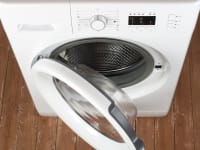10 things you need to know before buying a washing machine
Don't buy a washer before you read this
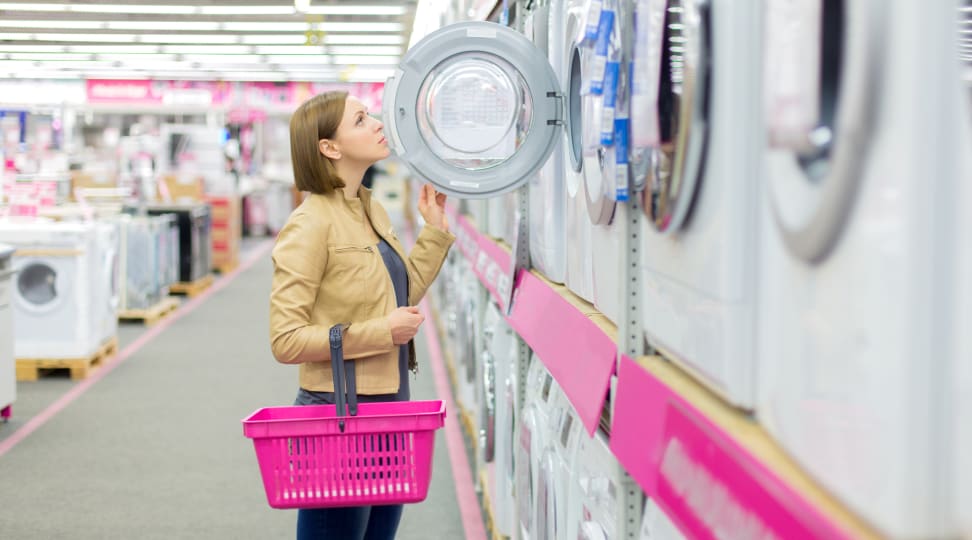 Credit:
Getty / 97
Credit:
Getty / 97
Recommendations are independently chosen by Reviewed's editors. Purchases made through the links below may earn us and our publishing partners a commission. Prices were accurate at the time this article was published but may change over time.
It’s great to have a washer in your home, a tremendous improvement over spending time in a laundromat. Whether you’d prefer having a compact in a closet, or a large capacity machine that’s the star of the laundry room, you're going to appreciate the convenience. Of course, when you're buying a new washer, you want to be certain you’re making the right choice.
Most people buy washers and dryers in sets, but you don’t have to. You do have to set a price range. You can buy a basic washer for $300, or you can invest close to $2000 in a machine with all the bells and whistles.
At Reviewed, we’ve tested more than 300 washing machines over the years, and we’re always willing to share our expertise. We’ve made a checklist to help you select your dream machine. When you’re finally set to buy, whether you’re replacing an old washer, or outfitting a new home, you’ll be ready.
Checklist
This list will help you prepare for a new washing machine. 1. Measure 2. Decide on a style 3. Set a budget 4. Determine how much capacity you need 5. Choose a finish 6. Find the features you want 7. Visit stores and sites, and take notes 8. Read reviews to educate yourself about performance and reliability 9. Select delivery and installation options 10. Plan for disposal of the old washing machine
1. Measure twice (or three times)
Most washers come in two widths, 27-inches or 24-inches. But you need to allow more room than that in your laundry. The water hookup takes about six inches of space, and you’ll also want to leave about an inch between the washer and the dryer. You also should make sure there's room to be able to stand in front of it and open the doors. If your laundry room has a low ceiling, and you want a top-loader, make sure you'll have enough space to raise the lid.
Trace the path the washing machine will take to get to your laundry space. Washing machines can be heavy and bulky (just like their cycles!). You don’t want your delivery to be derailed because the hallway door is too narrow or the basement stairs are winding.
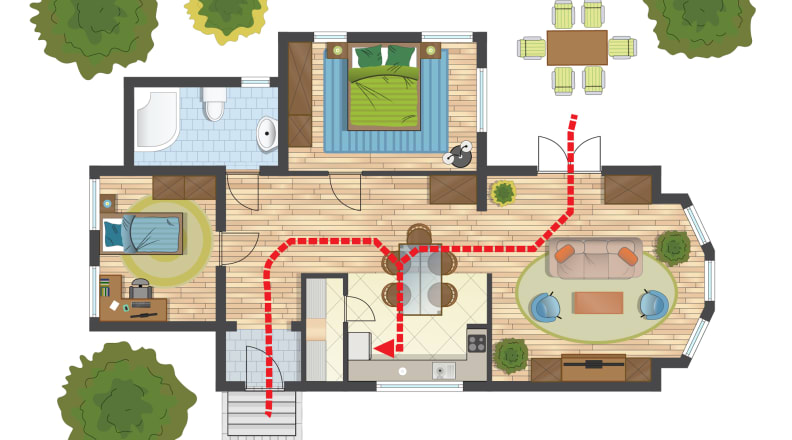
Make sure that there's enough room for the washer to pass through every door, hallway, and staircase on the way to the laundry room before you take delivery.
It may sound a little crazy, but if you're living in a small home, see if you can obtain a similarly sized cardboard box to stand in for the washer. Then, recruit a friend to help you carry it from your front door to your laundry space. If you find that you can’t fit a full-sized washer, think about alternatives. (Wait one minute—we’re about to explain that.)
2. Style

Top-loader — Your grandmother almost certainly had a machine like this, and lots of Americans still swear by them. Open the lid to reveal a deep tub with an agitator, which pushes clothes around to beat the dirt out of them. That might accelerate wear and tear.
This kind of washer can be the least expensive, but it uses more water than other types, along with the energy to heat the water, so factor in those costs when making a purchase decision.
Top-loaders don’t spin water out as effectively as other types of washers, so it takes longer for the dryer to dry them. See our Best Top-Load Washers with Agitators.
High efficiency top-loader — An HE top-loader closely resembles an old-school top-loader, but it's engineered to use water and energy more efficiently. HE top-loaders also need to use low suds HE detergents. These machines generally take longer to complete their cycles than regular top-loaders, and clothes can emerge wrinkled and twisted, due to smaller amounts of water usage and faster spin rates.
These washers remove more water than traditional top-loaders, so the trip through the dryer can be shorter.
Front-loader — Most Europeans have used front-load washing machines all along. These are more gentle on clothes, more like hand washing, and they use less water than top loaders, They can take a long time to complete some cycles, but they use less water, and spin faster, so clothes come out drier.
The scientific evidence convinces us that front-loaders are a great choice for many Americans. But there’s a sizable contingent that hates them. They believe all front-loaders are inevitably going to get moldy and stinky. But you can prevent that from happening to yours. Leave the door open when you’re not running a load to let the gasket dry. Wipe it each time, too. See our Best Front-Load Washers.
Compact front-loader — A compact front-loader can be a godsend when you’re living in a small condo or a tiny house, At just 24-inches wide, these don’t need a dedicated laundry room . You can fit one of these under the kitchen counter, or stack it in a closet with a compact dryer. (Of course, you’ll still need a water hookup.)
No doubt compacts can be pricey, but if space is tight, they can be the right choice. Though they might require you to do more frequent, smaller loads of laundry, compact front-loaders are economical with water and energy. See our Best Compact Washers.
3. Budget
In our testing at Reviewed, we’ve discovered excellent washing machines at a variety of price points. Before you shop, determine how much you’re able to spend. If your budget is generous, you can can go all out with big tubs, and cycles like steam and sanitizing.
4. Capacity
The size of your family and the amount of dirt they bring home on their clothes will determine how large a washer you need. If you live alone or with a partner, you may find that a compact washer is totally adequate. You can even get by with one if you have a small child. Toddlers are messy, but their clothes are tiny.
Larger families can benefit from bigger washing machines—that’s not rocket science. If you can do more laundry at once, you won’t have to do it all day.
The largest washing machines we’re reviewed are 6.2 cu.-ft., and a washer that size can handle enormous loads. Of course, if you’re buying a super-sized washer, make sure your dryer is big enough to handle all that laundry.
5. Finish
Washing machines no longer have to be white. Many models come in dark stainless finishes as well. Metallic or stone-like in color, these washers can look absolutely gorgeous. Of course, if your laundry room is in your basement, or you prefer a clean, classic look, white is always available.
6. Features
High-end models offer more cycles and advanced features. Or, you can be a minimalist, and stick with basic cycles—Normal, Heavy, Delicate, and Quick. If you’d like your washer to play a little tune when it’s done, you can have that. If you'd rather have it alert your smartphone, many washers can do that, too.
Detergent is an essential part of doing laundry, and some higher-end washers have features that make that a no-brainer. A newer model has a dispenser for laundry pods. We've even seen washers with detergent tanks that can take care of a month's worth of laundry, with no measuring needed.
7. Look and feel
Whether or not you're planning to order your new washer online, try to visit the "finalists" in a bricks-and-mortar store, if you can. It will help you determine whether the door is hard to open, the control panel is crowded, or the tub is too deep for you to reach that last pair of undies stuck to the bottom. Also, even with measurements in hand, it's hard to tell proportions online. Seeing the machine up close will give you a better idea of how well the machine will fit in your home.
8. Read the reviews
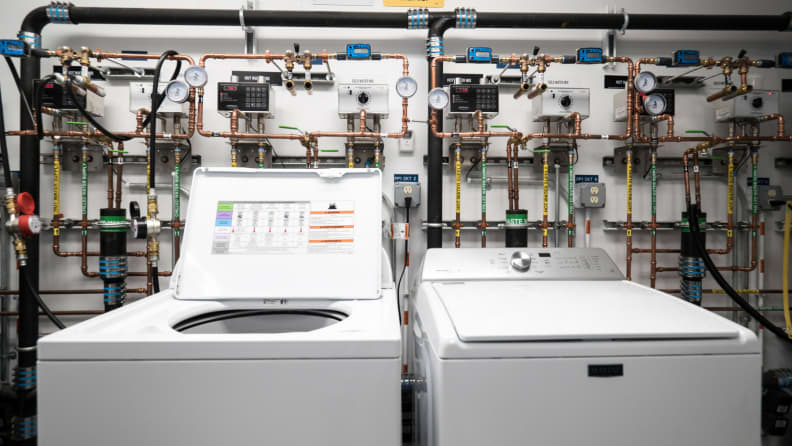
Our washer lab at Reviewed is where we do our testing.
Check our site and others to see what experts and owners say. Not all washing machines do a great job cleaning your clothes.
User reviews, taken as a whole, can help uncover trends in quality and reliability, though they won’t give you the full picture. Not everyone takes the time to write them. And don't forget personal recommendations from friends and family—often the most useful and personalized reviews of all.
9. Choose delivery options carefully

Any damage that occurs to your new washing machine is more likely to happen in the last 50 feet than in the factory. Make sure every door and hallway, from your front porch to your laundry room, is wide enough for the washer to pass through.
Delivery day can go smoothly or it can end in disaster. (See point #1.) Appliance damage is most likely to occur not at the factory, but in the last fifty feet to your house. Once the truck arrives, all the protective cardboard and foam is ripped away.
Investigate the options. Some retailers include delivery and installation with the price you pay for the washer, but don’t assume that’s always the case. Also, ask how your washing machine is going to be delivered. If the delivery service uses a two-wheeler, protect your floors, stairs, and door moldings, or they may get damaged.
Make a careful inspection of the washer before you sign for it. Examine the walls and floor of your house. Any scratches, dents, or holes caused by the delivery service? Once they leave it can be much harder to plead your case.
10. Arrange for disposal
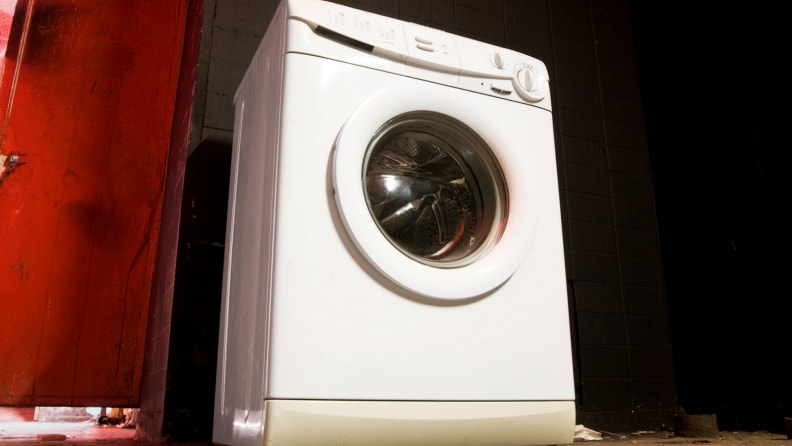
You may have to pay extra to get your old washing machine hauled away. Most retailers will take it away for a nominal charge, but be sure to find out ahead of time. Otherwise you could end up having to take care of it yourself, and washers are heavy.


